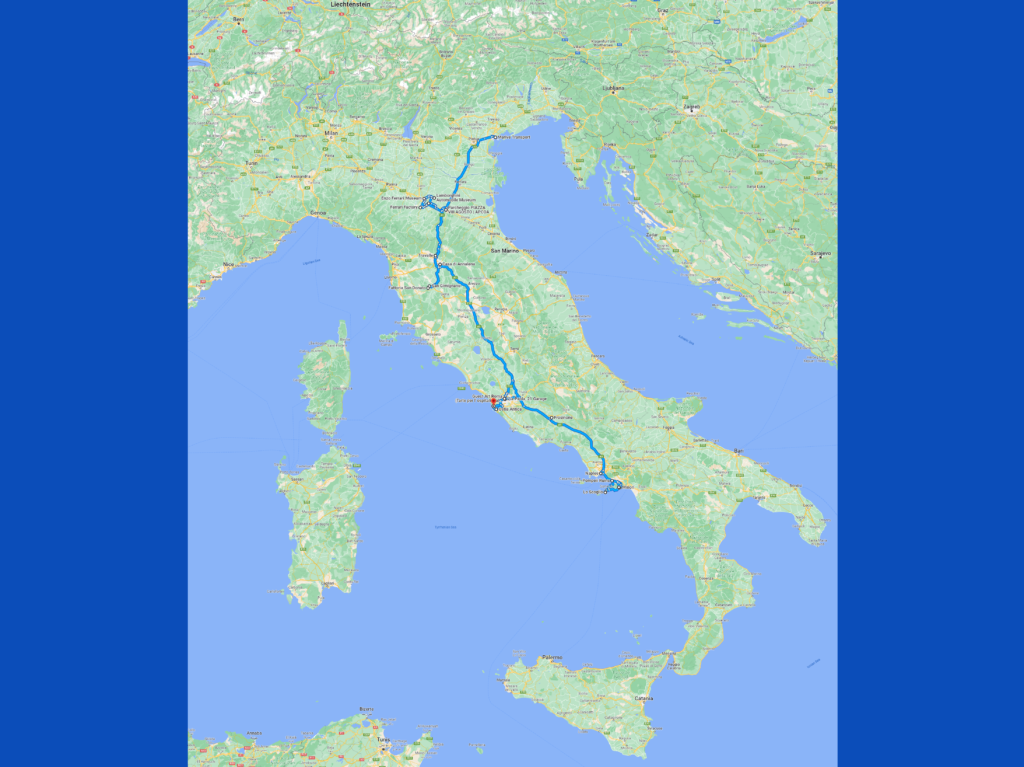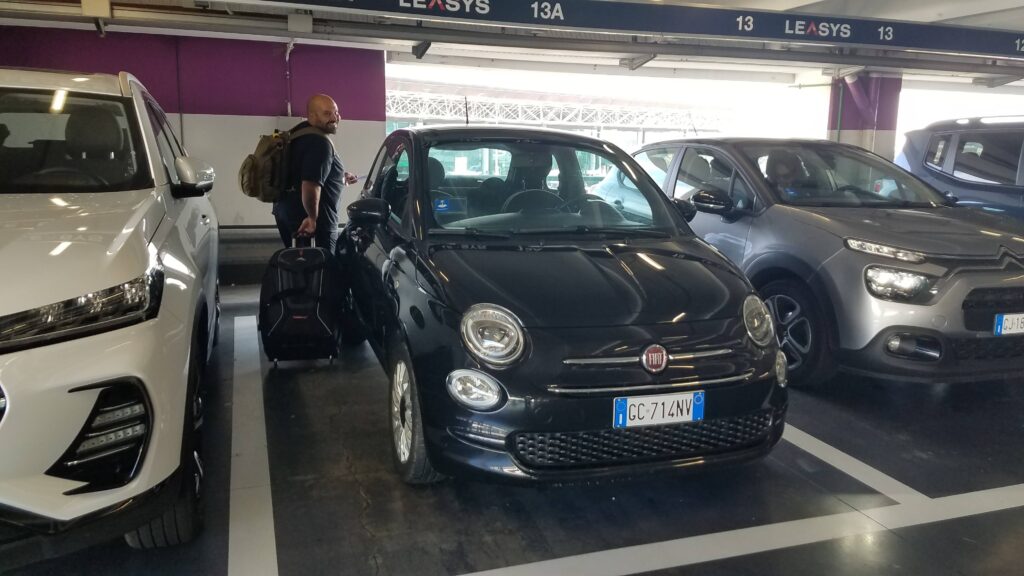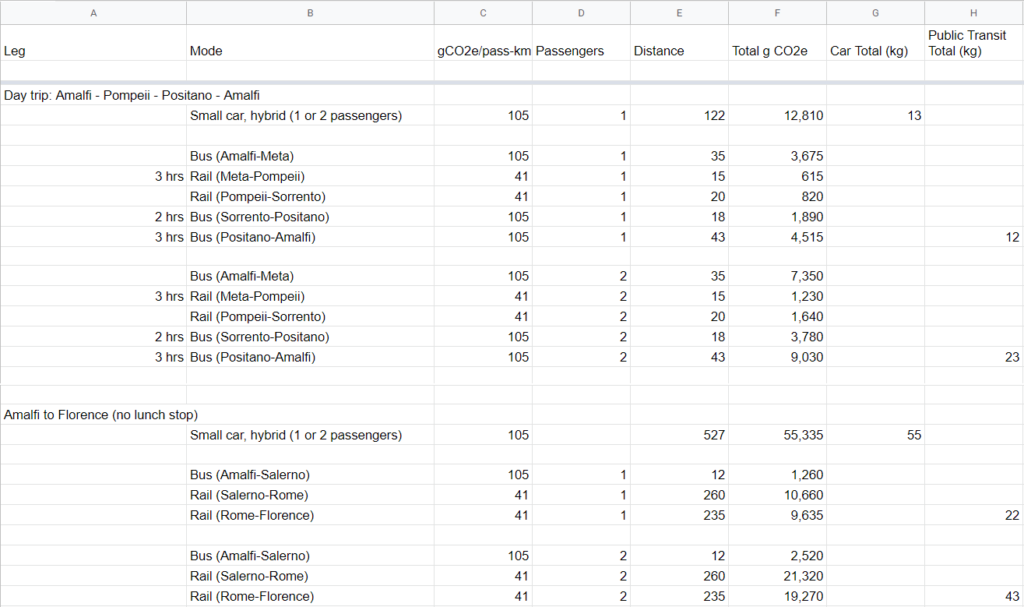When planning our trip to Italy last fall, Christian and I discussed our options for how to get around on the ground. A 15-day tour taking us to seven different stops, spanning the majority of the country (which is comparable in length to California) would require some reliable and affordable transportation. Of course, every country is different, and neither of us had ever been to Italy before. Cost, convenience, and carbon footprint were all factors we would have to weigh in the process.
We initially planned to buy rail passes, since they are a favorite option of ours in Japan (where they are not exactly cheap but are incredibly convenient). We knew we could get to major city centers quickly and easily enough and would have to take buses, taxis, or walk (with luggage) from there to get where we were staying. Averaging two nights per stop as we went, we wouldn’t have much opportunity to relax in each place and would be spending a considerable amount of time in transit with our bags.
Wanting to get off the beaten path whenever possible, we knew that a car could help make that happen, so we intended to rent a car twice: once for a three-night stay at a farm in Tuscany and once for a day trip to visit a series of car museums in and around Modena, which would have been impossible to do in a single day by bus. After Christian saw how cheap our car rental options were (about 10% of the cost to rent one for our west coast road trip in summer 2021), we made a quick decision to scrap the rail passes and drive the whole time.

Cost
Now, when we made that snap decision to cancel our rail passes, we were looking purely at the cost of renting the car, before adding a second driver (which turned out to be around $120 extra for two weeks) or any of the other associated costs. To rent a manual transmission Fiat 500 hybrid for two drivers for two weeks, we paid approximately $400 (the dollar was about equal to the euro at the time). The costs we know of – to date – include about $300 for gas (about 5 fills of a 35L tank, with gas at around €1.70/L… which comes to about $6.50/gallon, in case you thought prices in the US were high), about $300 for parking during that time (city centers are particularly pricey, of course), and any additional tickets we may yet receive for traffic violations.
I knew enough Italian from my three months of pre-departure Duolingo to read the highway signs pointing to speed cameras – the Italian government is quite kind to tell you when you’re approaching one so you can slow down. Using the cameras and identifying cars by their license plates, the police then send a ticket to the registered owner of the car, which in our case would be the rental agency, who presumably would then pass it along to us. From what I have read online about traffic tickets in Italy, it can take up to a year for them to reach their destination. (As it took six weeks for our postcards to arrive, that doesn’t surprise me in the least.)
The speed cameras on highways were something I knew about before we got to Italy. What I didn’t know about were the restrictions on where you can drive if you are not a resident. Most historic city centers limit vehicle access except on Sundays and holidays. Similarly, cameras at the entrance to these zones will snap your license plate and send you a ticket, which can be in the hundreds of dollars.[1] We were not aware of this restriction – or the exceedingly subtle signage – until the third stop of our trip, when an extremely friendly and helpful hotel concierge made sure we avoided a hefty fine.
As an alternative to our approximately $1,000 (or more?) travel costs in-country, we could have gone with our original plan of the rail passes, which would have cost us about $400 based on the number of days we had many miles to cover. [2] (You can select from several options, depending on how long you’ll be there and how often you plan to be traveling.) Certainly we still would have had to take buses, metros, taxis, and other forms of transportation, and I don’t know how much that all would have cost, but since Italian buses are considered to be affordable, I highly doubt that we would have racked up an additional $600 using public transportation for two weeks.

Convenience
But of course price wasn’t the only consideration. One of the things that we really love to do when we travel is get off the beaten path and avoid anything that might attract tourists. Having a car certainly enables that type of travel. Renting a car and deviating from what tourists are “supposed” to see is almost prohibitively expensive in Japan, for example, but it’s always nice when my Japanese mom drives us somewhere out of the way or lets me borrow her car – we have gotten quite spoiled in that respect. Knowing we would have a car in Italy for the full two weeks, we relied on it as an extended suitcase, picnic table, and even changing room on at least one occasion.
Having more flexibility with where we could go also meant we had more flexibility with when we could go. When I travel in a country where I rely primarily on public transportation, I tend to schedule the entire trip down to the minute in order to ensure that we don’t miss a train. That level of organization, while comforting in its structure, is also limiting in its potential. Having lived in Japan, my travel style 15 years ago was very organized and optimized in a “you can sleep when you’re dead” way. Having now taken more leisurely US-based road trips with Christian, I’ve loosened up a little bit and left space for discovery… which is exactly what I wanted when traveling to a brand new place.
There were three long travel days on our trip when we stopped for lunch at places that would have been difficult to get to without a car, and, frankly, even if public transportation were available to these places that clearly weren’t used to tourists, I know we wouldn’t have tried to cart our luggage along with us, waiting at bus stops for extended periods of time or walking down dusty country roads for miles after not being able to find a taxi. These three places – all of which we found en-route – ran the gamut of fanciness, but they all had at least one dish that was the most delicious something I had ever tasted, whether vanilla cream sponge cake, mushroom risotto, or Margherita pizza. Even if it cost a little more to have that level of freedom and ability to explore, I’m happy we had the chance to do it.
Carbon Footprint
All that said, financial cost vs. flexibility isn’t the end of the story. I live my life trying to minimize my environmental impact wherever possible and undoubtedly feeling guilty wherever I don’t. Carbon footprint is a big consideration for me and one of the biggest reasons I don’t travel more than I do. (Yes, I realize how incredibly fortunate I am to be able to say that.) It’s also important to note that by my very rough calculations, our flights to Rome and back represented almost 20 times the carbon footprint of our combined travel in-country (4,563 kg CO2-equivalent emissions to fly there and back vs. 250 kg CO2e to drive around for two weeks), so splitting hairs over driving a car or riding a train (which, you know I did) seems almost inconsequential in the greater scheme of things. That being said, it wouldn’t be a legitimate post on this blog without diving into the numbers…

During our two weeks of travel, we covered 2,391 km in our little Fiat “Cinquecento” hybrid, over which we can guess that we generated approximately 251 kg of CO2e. Granted, the benefits of a hybrid are seen more in the city or on a winding mountainside than on highway, but we did some of both, and – again – these are generalizations. According to “Our World in Data,” a website I have referenced on this blog many times before, a small hybrid car creates approximately 105 g CO2e per kilometer. If looking at mass transit, each passenger on a bus is responsible for about 105 g/km; on a train, 41 g/km; and on a plane, anywhere from 150g/km on long-haul flights to 255g/km on domestic flights. Again, these numbers are generalizations with plenty of assumptions made.[3]
Data Tangent: For those of you who know me, it will be unsurprising for you to hear that I created a spreadsheet comparing potential emissions for the entire trip in a car vs. on public transportation. I then dragged Christian semi-willingly into a discussion around how to calculate our individual footprints vs. our footprint as a couple when taking public transit. For example, if 10 people are riding a bus, each person is responsible for 10% of that bus’ emissions while they ride. Given that, two people riding that bus would be responsible for 20% of the bus’ emissions. On the other hand, if Christian were riding the bus by himself, it wouldn’t create more emissions (except very, very marginally) if I got on. Ultimately, I wasn’t sure which was more true to the situation: counting one person on public transit or doubling it to account for both of us. Of course, I calculated both – just to see.
It was not surprising at all to see that on long travel days, e.g. when we drove from Amalfi to Florence, the impact of driving a car (even a hybrid, which doesn’t really help on the highway) was greater than if we had taken a train – a little bit higher if we count two people on the train, but more than double if it’s one person. However, what really surprised me was how much it was a wash in town. Christian was not surprised, since the buses we saw were older, diesels, and possibly uncatalyzed, while we were in a tiny hybrid. According to my calculations, our day trip around the Amalfi Coast would have been comparable from a carbon footprint standpoint for one person driving or riding, but significantly better for two people in a car than on a bus.
Recipe: Margherita Pizza
What these calculations showed me (SWAGs though they may be) was that it does appear that short-distance travel – at least in these situations – could be done in an economical car without too much guilt, while long-distance travel would be better on more efficient transport (such as rail). However, as I mentioned above, there were delicious adventures in locations we never would have seen if not for the flexibility of zen-navigating into a city center, parking at the first lot we found, and walking to a hole-in-the-wall pizza shop, as we did in Naples… where I had the best Margherita pizza of my life.

I do not claim to be a pizza expert or a skilled cook. In fact, I have now made exactly four from scratch, all since returning from Italy. But the rapid improvement over those four pizzas has been so impressive that Christian bought me a new pizza stone and peel, and I have since stated that I never want to order a pizza again. Dear friends and neighbors of ours gave me a pizza cookbook over a year ago, and while nothing I’ve made is anywhere near the quality we had in Italy, I was thrilled to finally break out this book and make some truly delicious pizza.[4]
Pizza dough (makes four)
- 500 g all-purpose flour
- 16 g fine sea salt
- 350 g water
- 1 g active dry yeast
Pizza toppings (for one)
- 70 g tomato sauce
- 70 g fresh mozzarella
- 10 g parmigiano
- 6 basil leaves
- Pinch of sea salt
Blend flour, yeast, and salt. Add water and mix thoroughly. Cover the dough and let it rise at room temperature for about 18 hours.
Turn out dough onto a floured board and divide into 4 equal parts. Unused dough should be covered, refrigerated, and used within 3 days.
If you have an electric oven with a broiler on top, which I do (blog post to come on electric vs. gas in the future…), move your rack and pizza stone to the highest setting and preheat to 500F for half an hour. Then open the door for 30 seconds, close, and switch the oven to broil for 10 minutes while you’re prepping the pizza.
Work one ball at a time into a pizza crust that is 10-12 inches (yes, I’m mixing metric and imperial) and place it on a pizza peel (paddle). Add the sauce and mozzarella, and slide it onto the pizza stone when the oven is ready. It should be cooked in about 6 minutes, but keep an occasional eye on it – it should be bubbly and slightly charred on the edges. Pull it out and top with the parmigiano, salt, and basil leaves.
~
With that, I would love to hear about your own travel experiences and if carbon footprint impacted your own decisions. I would also love to hear about your pizza experiences – if you make it or if you had a particularly amazing one somewhere.
Thanks for reading!
[1] https://stayclosetravelfar.com/complete-guide-driving-in-italy/
[2] https://www.eurail.com/en/get-inspired/top-destinations/italy-train
[3] https://ourworldindata.org/travel-carbon-footprint
[4] https://www.goodreads.com/en/book/show/12131648-my-pizza
0 Comments